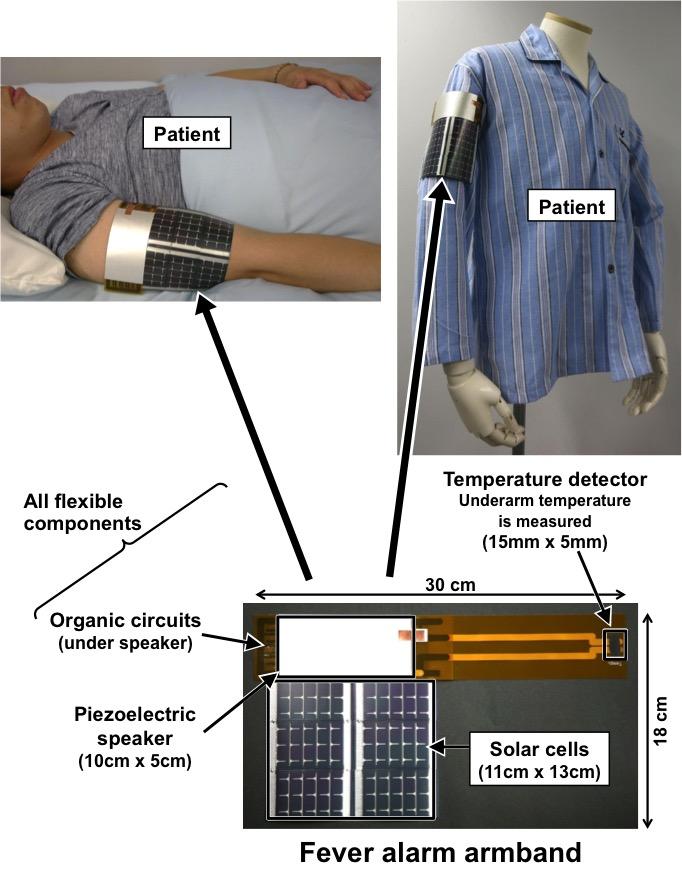Fever alarm armband: A wearable, printable, temperature sensor

The armband is 30 cm long and 18 cm wide, and can be worn either directly on the skin or on top of clothing. The device is designed so that the thermal sensor is located between the arm and the body. The organic power supply circuit is located under the piezo film speaker to reduce surface area. © 2015 Sakurai Lab. / Someya Lab.
The new device developed by research groups lead by Professor Takayasu Sakurai at the Institute of Industrial Science and Professor Takao Someya at the Graduate School of Engineering combines a flexible amorphous silicon solar panel, piezoelectric speaker, temperature sensor, and power supply circuit created with organic components in a single flexible, wearable package.
Constant monitoring of health indicators such as heart rate and body temperature is the focus of intense interest in the fields of infant, elderly and patient care. Sensors for such applications need to be flexible and wireless for patient comfort, maintenance-free and not requiring external energy supply, and cheap enough to permit disposable use to ensure hygiene.
Conventional sensors based on rigid components are unable to meet these requirements, so the researchers have developed a flexible solution that incorporates organic components that can be printed by an inkjet printer on a polymeric film.
The fever alarm armband incorporates several first-ever achievements. It is the first organic circuit able to produce a sound output, and the first to incorporate an organic power supply circuit.
The former enables the device to provide audible information when the flexible thermal sensor detects a pre-set value within the ranges of 36.5 ºC to 38.5 ºC, while the latter increases the range of operational illumination by 7.3 times in indoor lighting conditions.
“Our fever alarm armband demonstrates that it is possible to produce flexible, disposable devices that can greatly enhance the amount of information available to carers in healthcare settings,” says Professor Someya.
“We have demonstrated the technology with a temperature sensor and fever alarm, but the system could also be adapted to provide audible feedback on body temperature, or combined with other sensors to register wetness, pressure or heart rate.”
Journal article
Hiroshi Fuketa, Masamune Hamamatsu, Tomoyuki Yokota, Wakako Yukita, Teruki Someya, Tsuyoshi Sekitani, Makoto Takamiya, Takao Someya, and Takayasu Sakurai “Energy Autonomous Fever Alarm Armband Integrating Fully Flexible Solar Cells, Piezoelectric Speaker, Temperature Detector, and 12V Organic Complementary FET Circuits.” Paper to be presented at the 2015 IEEE International Solid State Circuits Conference San Francisco 22-26 February, 2015
Links
- The University of Tokyo http://www.
u-tokyo. ac. jp/ en/ - Graduate School of Engineering http://www.
t. u-tokyo. ac. jp/ etpage/ - Institute of Industrial Science http://www.
iis. u-tokyo. ac. jp/ index_e. html - Sakurai Laboratory http://lowpower.
iis. u-tokyo. ac. jp/ - Someya Group Organic Transistor Lab http://www.
ntech. t. u-tokyo. ac. jp/ - ERATO Someya Bio-Harmonized Electronics Project http://www.
jst. go. jp/ erato/ someya/ en/ index. html
Research contact information
Professor Takayasu Sakurai
Institute of Industrial Science
The University of Tokyo, Komaba 4-6-1, Meguro-ku, Tokyo 153-8505, Japan
Email: tsakurai@iis.u-tokyo.ac.jp
Tel: +81-3-5452-6251/6253
Fax: +81-3-5841-6252
Professor Takao Someya
Department of Electrical Engineering and Information Systems
Graduate School of Engineering
The University of Tokyo, Hongo 7-3-1, Bunkyo-ku, Tokyo 113-8656, Japan
Email: someya@ee.t.u-tokyo.ac.jp
Tel: +81-3-5841-0411/6756
Fax: +81-3-5841-6709
Japan Science and Technology Agency (JST) project contact
Tsuyoshi Nakamura
Department of Research Project
Japan Science and Technology Agency (JST)
Tokyo Headquarters K's Gobancho, 7 Gobancho, Chiyoda-ku, Tokyo 102-0076, Japan
Tel: +81-3-3512-3528
Fax: +81-3-3222-2068
Email: eratowww@jst.go.jp
Funding
Japan Science and Technology Agency (JST)
Exploratory Research for Advanced Technology (ERATO)
JST ERATO Someya Bio-Harmonized Electronics Project
Media Contact
All latest news from the category: Information Technology
Here you can find a summary of innovations in the fields of information and data processing and up-to-date developments on IT equipment and hardware.
This area covers topics such as IT services, IT architectures, IT management and telecommunications.
Newest articles

High-energy-density aqueous battery based on halogen multi-electron transfer
Traditional non-aqueous lithium-ion batteries have a high energy density, but their safety is compromised due to the flammable organic electrolytes they utilize. Aqueous batteries use water as the solvent for…

First-ever combined heart pump and pig kidney transplant
…gives new hope to patient with terminal illness. Surgeons at NYU Langone Health performed the first-ever combined mechanical heart pump and gene-edited pig kidney transplant surgery in a 54-year-old woman…

Biophysics: Testing how well biomarkers work
LMU researchers have developed a method to determine how reliably target proteins can be labeled using super-resolution fluorescence microscopy. Modern microscopy techniques make it possible to examine the inner workings…





















